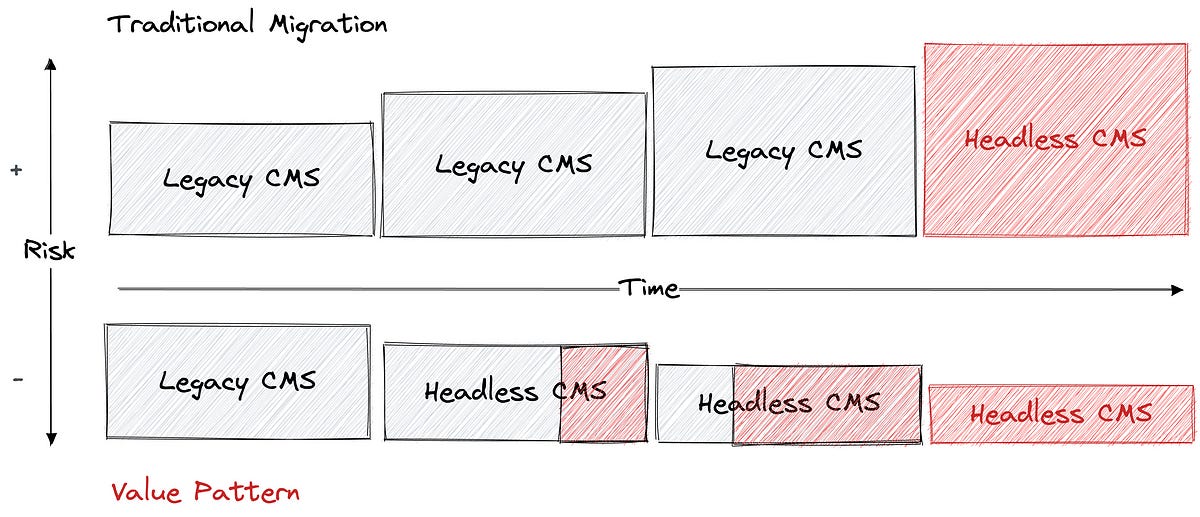The Value Pattern: Migrating to Headless CMS with Confidence
Unleash the power of the Value Pattern for CMS migration: reduce risk, boost quality control, and save costs while driving business growth.
In the dynamic world of digital content, a Content Management System (CMS) is the beating heart that drives a brand’s online presence. A robust CMS enables businesses to manage and publish their digital content effectively and plays a vital role in engaging audiences and driving conversions. However, as technology and user demands evolve, a traditional CMS may no longer provide the flexibility and performance needed. Enter the realm of headless CMS, a forward-thinking alternative that allows brands to deliver rich content experiences across multiple platforms with unprecedented agility.
While the thought of migration from a traditional CMS to a headless CMS may seem daunting, there’s a new approach that can make this transition smoother and less risky: The Value Pattern. The name may sound unfamiliar, but the concept will resonate with anyone who has faced the puzzle of upgrading their system without disrupting ongoing operations.
In contrast to the ‘Big Bang’ or turnkey migration approaches, which often involve completely overhauling the system all at once, the Value Pattern is more evolutionary. It allows for a gradual transition, where the new system grows in parallel with the old, slowly taking over functionality until the old system can be safely retired.
In this comprehensive guide, we will delve deep into the world of headless CMS, the migration challenges often faced by businesses, and how the Value Pattern provides a powerful, flexible solution for seamless migration.
Understanding CMS Migration
Digital technology is constantly changing, and staying competitive means adapting to these changes swiftly and efficiently. Content Management Systems (CMS) are no exception. As the backbone of your digital presence, the CMS you utilize can significantly impact your business’s ability to engage audiences, manage content and, ultimately, drive growth.
Traditionally, CMSs were monolithic structures, with frontend and backend systems tightly coupled together. It means that changes to one part of the system often affect others, leading to a complex, slow, and inflexible process. Businesses were tied to specific presentation layers and often found it challenging to deliver content across multiple platforms or to adapt to new technologies or trends rapidly.
Enter the headless CMS, a game-changer in the world of digital content management. In a headless CMS, the backend and frontend are decoupled, allowing content to be created and managed separately from its presentation. Moreover, content can be delivered across various platforms — a website, mobile app, IoT device, or even AR/VR applications — with remarkable ease and consistency. The benefits are manifold:
Enhanced flexibility.
Quicker time to market.
Scalability.
The ability to keep up with the ever-evolving digital landscape.
However, the transition from a traditional CMS to a headless one is not without its challenges. The CMS migration process involves moving existing content and functionality from the old system to the new one. It’s a complex task that requires careful planning, resource allocation, and execution.
The most common approach to migrations is the ‘Big Bang’ or turnkey migration. Here, the entire system is replaced at once, with content and functionality moved to the new CMS at some stage in the process. While this approach may seem efficient, it comes with many risks. It is often disruptive, high risk, and requires significant upfront investment before producing any return on investment. In addition, any unforeseen issues during the migration can lead to extended downtime and extra costs, negatively affecting business operations. Moreover, such a major change can be stressful for team members, who must quickly adapt to the new system.
Here is where the Value Pattern comes into play. Offering a more gradual, controlled migration approach, the Value Pattern allows for incremental changes, reducing the potential for disruption and making the migration process more manageable. In the following sections, we’ll delve deeper into what the Value Pattern entails and how it contrasts with the Big Bang approach in migrations.
The Value Pattern
As we navigate the terrain of CMS migration, it’s essential to understand that every journey is unique, and every destination has its own set of challenges. However, the path we choose can make a significant difference in how efficiently we overcome these challenges. The Value Pattern provides an evolutionary path for CMS migration, enabling risk mitigation, control, and adaptability while focusing on time-to-value. In other words, the goal is to generate a return on investment as early as possible, where sunsetting the legacy system is just one element of the strategy to generate more value.
This pattern takes inspiration from the strangler fig tree, which begins as a seed that lands on a host tree. As it grows, it sends roots down the host’s trunk while reaching toward the sunlight. Eventually, it covers the host tree completely, replacing it. However, the strangler fig does not harm the host but survives it by growing in the spaces left by its decay. This metaphor powerfully illustrates the Value Pattern, where our fig tree prioritizes producing high-quality fruit quickly.

In the context of CMS migration, the Value Pattern approach involves building the new headless CMS in parallel with the existing traditional CMS. Instead of trying to migrate everything at once, you identify key areas of functionality or content and migrate them one at a time. The new system gradually takes on more workload as each piece is moved. This method allows the new CMS to grow around the old one, eventually replacing it entirely.
This process’s beauty lies in its incremental nature. Unlike the ‘Big Bang’ approach, which could be likened to uprooting and replanting a tree, the Value Pattern lets the new system grow organically, taking over the responsibilities of the old system piece by piece. This results in minimal disruption to ongoing operations reduces risks and overall workload, and allows for more effective quality control, as each part is tested and improved before the next is migrated.
In the following sections, we will explore the step-by-step process of the Value Pattern, compare it with the Big Bang approach, and explain why it’s a smart choice for businesses planning to migrate to a headless CMS. Whether you’re an SME or a large enterprise, understanding and adopting the Value Pattern can be the key to a successful value-generation CMS migration.
The Value Pattern Process
The beauty of the Value Pattern lies in its flexibility. Breaking down the massive task of a CMS migration into manageable chunks mitigates risks, minimizes disruption, and offers an opportunity for incremental learning and continuous improvement. Let’s look into this organic approach step by step:
Step 1: Identify Key Areas for Migration and Prioritize Them
The first step in the Value Pattern approach involves identifying and prioritizing the functionalities or content areas to be migrated. It requires a thorough analysis of your existing CMS and an understanding which areas would benefit most from the headless CMS’s features. These could be areas that require frequent updates, have high user interaction, drive revenue, or need to be displayed across multiple platforms.
Remember, the goal isn’t to migrate everything at once but to start with critical areas that will give you the most value. Prioritizing areas based on business value, technical feasibility, and user impact can guide your migration strategy.
Step 2: Build the New System in Parallel
Once you’ve identified the first area to be migrated, start building that functionality in the new headless CMS. It is done in parallel with the existing system, which continues to operate as usual. The new CMS should have the necessary infrastructure, integrations, and workflows to support the duo operation.
During this stage, engaging all relevant stakeholders, including content creators, developers, and end-users, is important to ensure the new system meets their needs and expectations. In addition, automation testing and feedback loops are critical to ensure quality and usability.
Step 3: Gradual Cutover to the New System
It’s time for the cutover once the new functionality is ready and tested. The new headless CMS now handles all requests for that particular functionality. The old system still handles other functionalities, but the new system has taken over for this specific area.
Monitoring the new system closely during this period is recommended to catch any issues early and ensure a smooth transition. Again, keep communication channels open with all stakeholders to gather feedback and make necessary adjustments.
Step 4: Repeat for the Next Area
Once you’ve successfully migrated the first area and are satisfied with its performance in the new CMS, it’s time to repeat the process with the next area on your priority list. Identify the next functionality, build it in the new system, and gradually cut over.
Step 5: Retire the Old System
This iterative process continues until all functionalities have been migrated to the new headless CMS. At this point, the old system can be safely retired. You have successfully strangled the old CMS, replacing it entirely with the new, more agile, and flexible headless CMS.
The Value Pattern is not just a method but a philosophy that places control, risk mitigation, and continuous improvement at the heart of CMS migration.

Benefits of the Value Pattern
Adopting the Value Pattern for your CMS migration brings many benefits that reach beyond the technological realm and into your organization’s strategic, operational, and even organic aspects. Here are some key advantages:
Reduced Risk and Business Disruption: By focusing on incremental changes rather than a complete system overhaul, the Value Pattern significantly minimizes risks associated with migration. There’s no big switch-off moment where everything could go wrong. Instead, each part is migrated, tested, and adjusted separately, ensuring any issues are identified and resolved before moving on to the next. This gradual approach also minimizes disruption to ongoing operations, making the transition smoother for all stakeholders.
Better Quality Control: The Value Pattern allows for more effective quality control. As you’re only dealing with one piece of functionality at a time, you can thoroughly test and debug each part before migrating the next. Therefore, it ensures that errors are isolated and don’t impact the entire system, leading to a more stable and reliable CMS.
Increased Flexibility and Adaptability: One of the major benefits of the Value Pattern is the ability to pivot and adapt as needed. If an issue arises during the migration of one area, you can adjust your strategy without affecting the entire migration process. Additionally, this approach allows you to continuously improve and optimize your new CMS as you learn more about its capabilities and how users interact with it.
Cost-effectiveness Over Time: While setting up a new system in parallel may require some initial investment, the Value Pattern can prove more cost-effective in the long run. By minimizing risks and disruptions, you can avoid costly downtime and potential loss of revenue. Moreover, the continuous improvement aspect of this approach ensures that your new CMS remains relevant and efficient, maximizing your return on investment.
The Value Pattern presents a methodical, controlled, and flexible approach to CMS migration that respects your business’s pace and specific needs. It provides the exciting opportunity to gradually and seamlessly transform your digital content management, minimizing risks while maximizing benefits.
Cases: The Value Pattern in Action
The Value Pattern shines brightest in practical application, demonstrating its adaptability, efficiency, and risk-mitigating nature. To better illustrate its impact, let’s examine three cases:
Case 1: News Outlet with Millions of Pages of Content

A well-established news outlet with millions of content pages, landing pages, a restricted area for subscribers, and a subscription management portal needed help with its traditional CMS’s inflexibility and high maintenance costs. So they opted for a Value Pattern migration to a headless CMS.
They started by identifying and migrating key functionalities, starting with the high-traffic landing pages and subscription management portal. Then, running the new CMS in parallel ensured uninterrupted service and a smooth transition for their subscribers.
The outcome was impressive: a seamless transition that went unnoticed by millions of daily users and led to a 22% reduction in infrastructure and licensing costs. This considerable saving resulted from the reduced hardware requirements and the elimination of expensive proprietary software licenses inherent to their former monolithic CMS.
Case 2: PaaS Product Shifting Strategy
A PaaS provider shifting strategy from SME to Enterprise used the Value Pattern for their CMS migration. It was an opportunity to move to a headless CMS and rebrand and revisit their UX to align with their new market focus.
Starting with their high-conversion landing pages, they gradually migrated their content, optimizing their UX design and SEO strategy with each step. The new headless CMS allowed them to experiment — A/B Testing — and adapt their content strategy dynamically to cater to their new B2B audience, all while keeping their site live and available.
The results were transformative: not only did the migration go seamlessly, but they also saw a surge in their organic SEO and a whopping 40% increase in conversions on their landing pages. In addition, their new brand identity resonated with their Enterprise audience, proving that a CMS migration can drive significant growth when strategically aligned with broader business objectives.
Case 3: Online E-commerce Store Embracing Composability

An online E-commerce store with $500 million in annual revenue decided to adopt a composable approach, opting for a headless CMS and composable commerce strategy. Their goal was to improve performance, provide a better customer experience, and ultimately increase their bottom line.
They started with the most critical components of their e-commerce platform, such as product listing and shopping cart functionality. Then, running the new CMS parallel to the old system allowed continuous operations and an uninterrupted customer experience.
The outcome was an enhanced customer journey, significantly improved website performance, and an 8% bottom-line improvement. In addition, adopting the headless CMS and a composable approach delivered a more tailored shopping experience, leading to increased customer satisfaction and higher sales.
These cases illustrate the power and flexibility of the Value Pattern. It shows that CMS migration isn’t merely a technical decision; it’s a strategic one that, when done right, can lead to cost savings, increased conversion rates, and even a direct impact on the bottom line.
Planning Your CMS Migration: A Step-by-Step Guide
Successfully migrating from a traditional CMS to a headless one using the Value Pattern requires lean planning and strategy. This guide provides a step-by-step roadmap to navigate your journey smoothly and efficiently.

Identifying the Need for Migration: Key Indicators
Recognizing the signs that your current CMS is no longer serving your business needs is the first step in the migration process. Here are some key indicators that it might be time to consider migration:
Inflexibility: Your current CMS is inadequate for adapting to changing market trends and delivering content across multiple platforms and devices. If your marketing team cannot keep up with the market’s pace, then migrating to a more flexible system and architecture is necessary.
High Maintenance Costs: You’re spending a significant portion of your budget on CMS maintenance, including hardware, software licenses, and IT support.
Poor Performance: Slow loading times, frequent downtimes, or other performance issues impact your user experience, SEO rankings, and conversion rates.
Lack of Features: Your CMS doesn’t support modern features like personalization, A/B testing, analytics, or multi-language support.
Assembling Your Team: The Roles and Responsibilities
The next step is assembling a migration team to plan and implement your CMS migration effectively. A well-rounded team will typically include the following:
Product Manager: Coordinates all aspects of the migration, sets timelines, and manages communication among team members and stakeholders.
Solution Architect: Oversees the technical aspects of migration, including setting up the new CMS, data migration, testing, and debugging.
Software Developers: Develop the solution and content models, enabling composability and evolutionary approaches.
Content Manager: Leads the content strategy, works on content mapping and structuring in the new CMS, and ensures seamless content transfer.
UX/UI Designer: Responsible for designing the user interface on the new CMS and ensuring a consistent, engaging user experience across all platforms.
Stakeholders: Business owners, product managers, marketing professionals, or other key stakeholders who understand the business goals and can provide valuable input.
Developing a Migration Plan: Key Steps and Milestones
With your team in place, the next step is developing a detailed migration plan. This plan should include key steps and milestones, such as:
Content Audit: Review all existing content and functionality to decide what needs to be migrated, archived, or discarded.
Priority Setting: Identify the key areas to be migrated based on business value, technical feasibility, and user impact.
Technical Setup: Set up the new CMS, including necessary infrastructure, integrations, and workflows.
Content Migration: Migrate content and functionality to the new CMS one area at a time.
Testing and Debugging: Test each migrated part thoroughly and fix any issues before moving on to the next.
Launch and Monitor: Once all areas have been migrated and tested, retire the old CMS and monitor the new one closely for potential issues.
Best Practices
As you implement the Value Pattern, here are some best practices and potential pitfalls to consider:
Incremental Migration: One of the biggest advantages of the Value Pattern is the ability to migrate incrementally. Resist the temptation to rush the process. Take the time to test and optimize each part before moving on to the next. Also, take the opportunity to iterate feedback loops and improve further your strategy and goals.
Stakeholder Communication: Regular communication with all stakeholders is crucial. Keep everyone informed about the progress, challenges, and successes to ensure continuous buy-in and support.
Focus on User Experience: Always maintain sight of the end user during the migration. Whether you’re working on the backend or frontend, always consider how your decisions will impact the user experience.
Continuous Improvement: The Rangle Pattern promotes a philosophy of continuous improvement. Use the insights gained from each migration phase to refine and enhance subsequent ones. Post-migration, keep analyzing and optimizing your CMS to ensure it continues to serve your business needs effectively.
Pitfalls to Avoid
Underestimating the Time and Effort Required: CMS migration is a significant project that requires planning and execution. Make sure to allocate sufficient time and resources to ensure a smooth transition.
Skipping the Content Audit: Failing to perform a content audit can lead to unnecessary work migrating outdated or irrelevant content. An audit helps identify what content to keep, update, or discard.
Overlooking Training: The new CMS will likely have different functionalities and workflows than the old one. Provide ample training to your team to ensure they can effectively use and manage the new system.
Neglecting SEO: Changing your CMS can impact your SEO. Ensure to implement proper redirects, retain metadata, and consider URL structures to maintain your search engine rankings.
Neglecting Architecture: A Headless CMS is only powerful if composability and flexibility are well-balanced and part of the strategy for content models and overall architecture.
The migration process may seem daunting, but by recognizing the need, assembling the right team, devising a robust plan, and implementing the Value Pattern with care and foresight, you can transform this challenge into an opportunity for growth and improvement. As real-world cases have shown, the benefits of a successful migration can be game-changing for your business.
In the ever-evolving digital landscape, adopting the Value Pattern for CMS migration is no longer a luxury; it’s a strategic imperative. This method reduces risk, offers superior quality control, and delivers significant cost savings, all while driving tangible business growth and improvement. As we’ve seen through real-world examples and a step-by-step migration guide, the Value Pattern provides an incremental, manageable, and ultimately successful pathway to digital transformation. We encourage all businesses facing CMS migration challenges to consider this powerful approach — it could be the game-changer you’re looking for.



